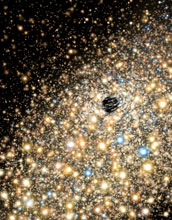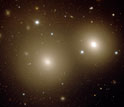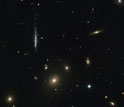News Release 11-254
Sleeping Giants Discovered
Largest black holes ever measured found in "nearby" galaxies

Artist's conception of the stellar environment around a black hole of about 10 billion solar masses.
December 5, 2011
This material is available primarily for archival purposes. Telephone numbers or other contact information may be out of date; please see current contact information at media contacts.
Astronomers recently discovered the most massive black holes to date. Found in two separate nearby galaxies roughly 300 million light years away from Earth, each black hole has a mass equivalent to 10 billion suns.
"We knew that really large quasars, which are powered by matter falling into black holes, existed in the early universe," said Chung-Pei Ma, an astrophysicist at the University of California, Berkeley and co-author of an article that will be published in Nature on December 8.
"What we hadn't yet found was where the remnants of those quasars--equally large black holes--were in the current universe," she said. "The boisterous quasars may have passed through a turbulent youth to become the quiescent giant elliptical galaxies we see today, harboring hidden black holes at their centers."
Black holes are made of matter so dense that even light can't escape their intense gravitational fields. Exploding stars--known as supernovae--can create relatively small black holes only a few times more massive than the sun, but researchers think these monster black holes are formed in different ways, such as multiple smaller black holes merging into one, or voracious growth by swallowing vast amounts of stars and gas while galaxies are forming.
The gigantic black holes discovered by Ma and her colleagues are so enormous they are capable of consuming anything within a region five times the size of Earth's solar system.
Researchers think that most, if not all, galaxies have a black hole at the center. The larger the galaxy, the larger the black hole it contains. Researchers suggest these blacks holes consume tremendous quantities of gas and dust from the central regions of the galaxy, at which point they become "dormant." The surviving gas may become stars that orbit peacefully within the galaxy.
Their quiet nature is part of what makes these sleeping giants so difficult to observe. "Since black holes cannot be seen, we have to detect them by carefully observing their immediate surroundings," said Nicholas McConnell, first author of the paper. "These galaxies contained enormous masses within a small central volume--too much mass to come from stars alone." These and other factors led the group to conclude that most of the mass is contained in massive black holes.
With support from the National Science Foundation (NSF), and using telescopes at the NSF-supported International Gemini Observatory, as well as the Keck and McDonald observatories, McConnell and Ma were able to map the velocities of stars orbiting the centers of massive elliptical galaxies--data the research team did not have the technical capability to obtain just a few years ago. The new results may help astronomers determine how black holes and galaxies form and develop together over the history of the universe.
"Galaxies are the places where stars and planetary systems form, and supermassive black holes in the early universe set the stage for their formation," said Tom Statler, program director for NSF's division of Astronomical Sciences.
"Black holes played a big role in making our universe what it is today."
-NSF-
-
Play Audio
UC-Berkeley astronomers describe massive black hole discovery at NSF audio press conference.
Credit and Larger Version -
An image of two giant elliptical galaxies obtained by the Gemini Observatory in March of 2008.
Credit and Larger Version -
This collection of galaxies is part of a much larger cluster of galaxies (Abell 1367).
Credit and Larger Version
Media Contacts
Lisa Van Pay, NSF, (703) 292-8796, email: lvanpay@nsf.gov
Lisa-Joy Zgorski, NSF, (703) 292-8311, email: lisajoy@nsf.gov
Robert Sanders, University of California, Berkeley, (510) 643-6998, email: rsanders@berkeley.edu
Program Contacts
Thomas Statler, NSF, (703) 292-4910, email: tstatler@nsf.gov
Co-Investigators
Chung-Pei Ma, University of California, Berkeley, (510) 301-3780, email: cpma@berkeley.edu
The U.S. National Science Foundation propels the nation forward by advancing fundamental research in all fields of science and engineering. NSF supports research and people by providing facilities, instruments and funding to support their ingenuity and sustain the U.S. as a global leader in research and innovation. With a fiscal year 2023 budget of $9.5 billion, NSF funds reach all 50 states through grants to nearly 2,000 colleges, universities and institutions. Each year, NSF receives more than 40,000 competitive proposals and makes about 11,000 new awards. Those awards include support for cooperative research with industry, Arctic and Antarctic research and operations, and U.S. participation in international scientific efforts.
Connect with us online
NSF website: nsf.gov
NSF News: nsf.gov/news
For News Media: nsf.gov/news/newsroom
Statistics: nsf.gov/statistics/
Awards database: nsf.gov/awardsearch/
Follow us on social
Twitter: twitter.com/NSF
Facebook: facebook.com/US.NSF
Instagram: instagram.com/nsfgov





